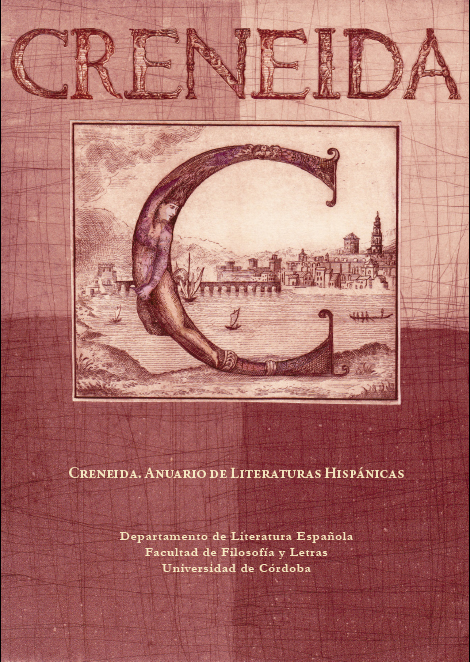The Presence of Juan de Mena in the Cancionero Musical de la Colombina ms. 7-1-28 (About Vuestros ojos que miraron)
Main Article Content
Abstract
Downloads
Publication Facts
Reviewer profiles N/A
Author statements
- Academic society
- Creneida. Anuario de Literaturas Hispánicas
Article Details

This work is licensed under a Creative Commons Attribution-NonCommercial-NoDerivatives 4.0 International License.
Avisos de derechos de autor propuestos por Creative Commons
1. Política propuesta para revistas que ofrecen acceso abierto
Aquellos autores/as que tengan publicaciones con esta revista, aceptan los términos siguientes:- Los autores/as conservarán sus derechos de autor y garantizarán a la revista el derecho de primera publicación de su obra, el cuál estará simultáneamente sujeto a la Licencia de reconocimiento de Creative Commons que permite a terceros compartir la obra siempre que se indique su autor y su primera publicación esta revista.
- Los autores/as podrán adoptar otros acuerdos de licencia no exclusiva de distribución de la versión de la obra publicada (p. ej.: depositarla en un archivo telemático institucional o publicarla en un volumen monográfico) siempre que se indique la publicación inicial en esta revista.
- Se permite y recomienda a los autores/as difundir su obra a través de Internet (p. ej.: en archivos telemáticos institucionales o en su página web) antes y durante el proceso de envío, lo cual puede producir intercambios interesantes y aumentar las citas de la obra publicada. (Véase El efecto del acceso abierto).
References
Anglés, Higinio, La música en la Corte de los Reyes Católicos. Polifonía religiosa, Madrid, CSIC, 1941, vol I.
Bonilla Cerezo, Rafael y Tanganelli, Paolo, “El Cancionero musical de la Colombina [SV1]. Fenomenología de los errores privativos y algunas huellas en los cancioneros literarios”, eHumanista, 38 (2018), pp. 915-926.
Cancionero musical de la Colombina (Siglo XV), ed. Miguel Querol Gavaldá, Barcelona, CSIC, Instituto Español de Musicología, 1971.
Dutton, Brian, Catálogo-Índice de la poesía cancioneril del siglo XV, Madison, 1982.
Dutton, Brian, El Cancionero del siglo XV (c. 1360-1520), Salamanca, Universidad de Salamanca, 1990-1991, IV.
Dumanoir, Virginie, “Melodía y texto. El caso de los romances viejos”, en Música y literatura en la España de la Edad Media y del Renacimiento, Madrid, Casa de Velázquez, 2003, pp. 107-116. DOI: https://doi.org/10.4000/books.cvz.2886
Elia, Paola y Zimei, Francesco, “Le ragioni di un approccio interdisciplinare”, en Il repertorio iberico del Canzoniere, N 871 di Montecassino. Musica e poesia alla corte aragonese di Napoli, Como-Pavia, Ibis, 2005, pp. 9-11.
Haberkamp, Gertraut, Die weltliche Vokalmusik in Spanien um 1500, Tutzing, Schneider, 1968.
Krogstad, Jineen, “La música y los cancioneros: 1480-1520”, en Apéndice II de Dutton, 1982, pp. 275-276.
Lida de Malkiel, María Rosa, Juan de Mena. Poeta del prerrenacimiento español, México, Colegio de México, 1950.
Nigris, Carla de “Oya tu merçed y crea”, en Juan de Mena, Poesie minori, Napoli, Liguori, 1988, pp. 294-296.
Pegera, Diego, Consuelo de los naçidos [ID 4351] (vv. 1-12).
Pérez Priego, Miguel Ángel, “Oya tu merced y crea”, en Juan de Mena, Obra lírica, Madrid, Alhambra, 1979, pp. 75-76.
Pons Rodríguez, Lola, “La lengua en el Cancionero musical de la Colombina”, en Cancioneros en Baena. Actas del II Congreso Internacional Cancionero de Baena, ed. Jesús L. Serrano Leyes, I, Baena, M. I. Ayuntamiento de Baena, 2003, pp. 588-608.
Robert Stevenson, Cantinelas vulgares puestas en música por varios españoles, Lima, Pacific Press, 1952.
Román, Comendador, Coplas de la pasión con la resurrección, ed. Giuseppe Mazzocchi, Firenze, La Nuova Italia, 1990.
Sierra Pérez, José y Gonsálvez Lara, José Carlos, Cancionero musical de La Colombina: cantinelas vulgares puestas en música por varios españoles (Siglo XV), ed. facs., Madrid, Sociedad Española de Musicología. Asociación Española de Documentación Musical, 2006.
Stevenson, Robert, Spanish Music in the Age of Columbus, The Hague, Martinus Nijhoff, 1960. DOI: https://doi.org/10.1007/978-94-011-9438-9
Tomassetti, Isabella, Mil cosas tiene el amor. El villancico cortés entre Edad Media y Renacimiento, Kassel, Edition Reichenberger, 2008.
Vallín, Gema y Toro Pascua, María Isabel, “Lírica culta, lírica tradicional: intercambios («Ver y desear»: un villancico popular de origen trovadoresco”, en La literatura popular impresa en España y en la América colonial: formas y temas, géneros, funciones, difusión, historia y teoría, dir. Pedro Manuel Cátedra García, Salamanca, Seminario de Estudios Medievales y Renacentistas-Instituto de Historia del Libro y de la Lectura, 2006, pp. 169-189.





